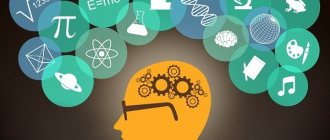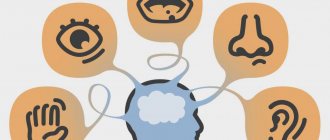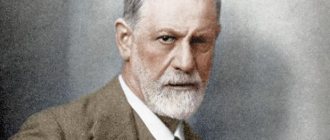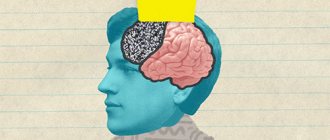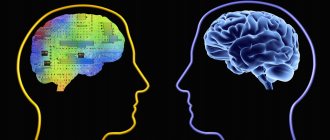The classification of types of memory is a complex system with many connections. Today, the most common approach to typifying memory is to identify the dependence of its characteristics on the specifics of the activity aimed at memorization and subsequent reproduction.
Memory is distinguished:
- according to the duration of data storage - long-term or short-term;
- by target activity – involuntary or voluntary;
- according to the characteristics of mental activity - figurative, emotional, motor (motor) and verbal-logical memory.
The largest group is represented by types of memory according to the characteristics of mental activity. All of them cannot fully exist and function separately from each other, since they interact very closely and the development of one is impossible without the progress of the other. However, the leading role is played by the verbal-logical branch, which, of all living organisms, is inherent only in humans. Many animals have motor, figurative and emotional memory in a primitive form, but only humans have verbal memory, and it must be developed intensively and systematically, starting from a fairly early childhood.
What is verbal-logical or verbal memory?
The main component of verbal memory is thoughts, thought processes, understanding of the phenomena being studied, analysis of judgments, the ability to draw conclusions, work with other people’s statements and thoughts heard from someone.
As is already clear from the name, this type of memory consists of two components - logical and verbal. The logical component, in contrast to the mechanical one, with the help of which a person remembers only the external data of an object/text, is aimed at understanding the meaning of the subject or topic being studied. Logical memory always involves mental work, in which the material is not simply memorized mechanically, but is preliminarily analyzed, broken down into logical fragments, from which important and secondary ones are then separated, relationships are built between all fragments, and thus the essence of the entire volume to be memorized is learned.
The result of any human mental activity is the verbal formulation of conclusions (it is impossible to convey thoughts without language) - it is also the verbal component of verbal memory. This component will not always be an exact copy of the source material, but rather will reflect only its meaning. That is, a person can explain the essence of the question in his own words, without memorizing a book answer. On the special educational resource “iClub”, anyone can test and train all existing types of memory. The site's materials are developed on the basis of scientific theories by experts in the field of psychology and teaching, and are presented in a playful way, especially interesting for children.
Verbal memory is formed on three other types - motor, figurative and emotional, but at the same time it is the main one, and only the degree of development of adjacent types of memory will depend on it. She plays a leading role in the assimilation of any knowledge.
The degree of development of verbal-logical memory is a litmus test of a person’s erudition, the level of his training, and the quality of knowledge. The learning of any schoolchild is ensured by verbal-logical memory, so its capabilities must be used as fully as possible, which means that the comprehensive development of verbal-logical memory is important. The more it is applied in life, the more successful a person’s activities become. An excellent memory, of course, cannot replace a brilliant mind, but it will become a reliable assistant in solving problems of any complexity. Developed memory greatly reduces the time it takes to perform any mental operation.
Emotional memory
How to develop memory in an adult - use emotions, some details are better imprinted if the event caused a storm of feelings. Emotions help you remember events that happened to you once, even though the level of sensitivity to these events decreases over time.
The peculiarity of this type of memory is that a person remembers three feelings especially vividly:
- fear;
- suffering;
- astonishment.
That is, we remember situations that have a negative connotation longer and more clearly than positive ones.
Developing emotional memory in adults exercises:
- Keep a diary in which you write down your emotions and experiences. Sometimes re-read it, trying to reproduce events based on the feelings you experienced.
- Periodically recall various positive events in your life, trying to feel the same emotions.
- Form a positive emotional state by reading the right books or watching good movies. Try to feel the state of the main characters. Based on these emotions, you can easily reproduce the content or plot.
The development of emotional memory will prevent negative events. In case of a previously experienced negative experience, it acts as a kind of stop signal that prevents you from committing erroneous actions.
Special exercises
The process of forming verbal-logical memory often occurs in preschool or early school age. The task of parents is to help children develop this type of memory by all available means, since the entire school curriculum is built on children’s ability to read, analyze, remember and retell information. It is especially important to work with children who have speech disorders, since they are worse than others in remembering new words, learning poems, and retelling fairy tales and events.
- Complete the assignment. The child only needs to voice the sequence of actions that he must perform once: go to the kitchen, open the refrigerator, in the refrigerator there is a vegetable drawer in which you take a red and green apple, wash the apples, take a towel, dry them and bring them to the room, give the red one to your mother , and eat the green stuff yourself, or vice versa. The child must remember and follow the entire algorithm; if it doesn’t work out the first time, continue training. Instructions, of course, need to be changed and complicated over time.
- Practice retelling. Read the texts and ask your child to retell them; if that doesn’t work, read again. Ask questions about the text that would stimulate thinking - why do you think the main character answered this way? What fairy tale is the situation similar to, etc. By answering questions, the child learns to think, draw conclusions, and formulate statements.
- Seven phrases. Tell your child seven phrases, for example: the dog is barking, the boy is crying, the fire is burning, it’s cold in winter, hot in summer, birthday, tomorrow is a day off. Let the child draw a picture for each phrase that would help him remember the phrase. At the end of the work, let him reproduce all the phrases from the pictures, help if necessary. Repeat the task the next day - will he remember or not?
- Mosaic. This is the name of the task in which the adult needs to ask the child several different words, 7-10 pieces, and the child must combine them into a single story. That is, come up with a story with meaning in which the specified words would appear.
- Group the words. Come up with 5-10 words that could be divided into groups: cup, parrot, table, titmouse, fork, sofa, chair, swallow, frying pan, board. Give your child the task of first repeating the sequence, and then breaking it into logical groups. Let him try to do this on his own; he will probably combine them in different variations, but this is only good, because it means that the child is thinking. If attempts do not lead to anything, suggest groups - furniture, birds, kitchen utensils.
- What did you hear? You need to choose an interesting poem and slowly read it to the child, and then ask him to depict (schematically) all the objects or animals that appeared in the poem.
- Answer the question. The task is practically a school one. It is necessary to familiarize yourself with the text and answer questions about it, both direct and those that require reflection. The child must learn to read, understand the material and find answers to any complex questions in it.
- Associations. Prepare pictures with various images, select logical words for them. For example: a picture of a Christmas tree, the word New Year, a cup for tea, lightning for rain, etc. Lay out the pictures in front of the child and read the words, let him demonstrate his associations. Then explain the principle by which the selection is made, and ask them to supplement the pictures with other associative words, and not just those that you named. Christmas tree - New Year, firewood, bird's nest, pine needles, forest, picnic.
- Lots of special games on .
Thanks to such simple and interesting tasks, the child will develop not only his memory, but also replenish his knowledge about the world around him, norms of behavior, and acquire new skills and abilities.
Olfactory memory
Smell is a great memory stimulant. According to experts, olfactory memory is much stronger than visual and auditory memory. This is due to the peculiarities of the structure of the brain. You've probably caught yourself more than once thinking about how some smell immersed you in memories, while a whole chain of events unfolded before your eyes, or a feeling of pleasant, warm nostalgia arose.
According to scientific research, association with a certain smell helps to better remember information. For example, when preparing for an exam, using an incense stick can increase memory efficiency by 30%. It is enough to remember this scent (if it is not possible to reproduce it in reality).
To train your olfactory memory, do the following simple exercises:
- Try to imagine the smell of orange, rose, chocolate, or your favorite perfume.
- Try to remember objects by smell.
This is interesting: In some cases, memory in patients with amnesia is restored when the association with a certain smell is triggered.
Visual memory
Color pictures
Show your child three to five pictures of different colors in a certain sequence and ask them to repeat. Swap places. Repeat the task
Geometric figures
Show a character made of geometric shapes. There should be no more than four figures.
Time to memorize 30 seconds.
Ask to draw what you remember. You can prepare three drawings in advance. At each subsequent one, change some detail.
Visual memory
Intellectual exercise “25 letters”
Participants are shown a table for 30 seconds.
The task is to find words that help you remember the table.
If the child finds it difficult to name words for a long time, you can show the table again for about five seconds.
At the end, you can show the table again so that you can find other words besides the five horizontally.
Figurative memory
Such memory in psychology is a reproduction of what is perceived in the form of ideas. Associated with it are pictures of nature and life, sounds, smells, tastes, etc. This type of memory is characterized by those features that make ideas faded, inexpressive, fragmentary and unstable. This is due to the difference between the previously perceived object and its image. Moreover, time can exacerbate these differences.
The difference from a real object can go in two directions:
- Mixing images. The image loses its parameters and what is common to the given object and other objects comes to the fore;
- Difference of images. In memory, the parameters characteristic of this image are strengthened, which places emphasis on the exceptional properties of the object.
The ease of image reproduction is influenced by two indicators:
- The content and emotional coloring of the image, the sensory state of a person.
- The state of a person at the moment of image reproduction. More accurate reproduction is inherent in those objects that were named in words during perception.
Motor memory
Motor memory is important not only for dancers or athletes, it is relevant for any person in the process of memorizing material. For example, when you type text on a computer, having the skill of fast typing, you concentrate your attention on the information, and not on hitting the right letters with your fingers, which significantly increases the level of mastering and memorizing data.
Note: How else can you quickly remember information? Associate information that needs to be recorded for a long time with a specific gesture. Thus, subsequently making this movement, you will be able to reproduce the necessary information.
But motor memory is of greatest importance for people whose work involves performing precise and complex movements: surgeons, musicians, dancers, etc. Developing motor memory is somewhat more difficult than its other types; you will need patience and willpower, but the main thing is still this In fact, it's practice.
How to develop motor memory:
- If the goal is to acquire a certain skill, you will have to repeat the same action so many times until it reaches the “reflex level.” The main condition is to carry out the algorithm of actions clearly and correctly, concentrating on the information or on the actions themselves.
- Exercise “Mushroom Glade”:
one hand is a mushroom, clench it into a fist and extend it in front of you
the second hand is a clearing, place your palm under an imaginary mushroom.
Your task is to suddenly change hands, turning a mushroom into a clearing, and a clearing into a mushroom, while your shoulders remain in place, your forearms, hands and fingers are involved. Speed up your movements each time.
- Stretch your arms in front of you and at the same time begin to rotate in different directions. As soon as it starts to feel free, change direction.
Note: Use motor memory if you need to learn a lecture: rewrite it or read it out loud.
Individual characteristics of memory
- Amount of information remembered . Standard volume - 7±2. Some people have unlimited capacity. Luria: “the person had no idea about the peculiarities of his memory.”
- Speed of information memorization;
- Strength of remembering information . The speed and strength of memorizing information are united by a relationship determined by the type of human temperament: choleric people have high speed and low strength, sanguine people have high values of both, phlegmatic people have low speed and high strength, melancholic people have low values of both.
- Memory type . It is determined by the most developed type of memory in a given person.
see also:
- Memory development;
- Factors of memory efficiency.
Testing
So, it's time to move on to practice. What do you need to do to determine how well your verbal memory is? The test is mainly carried out only on young children under the age of ten, since in adults the level of verbal intelligence or verbal memory can be a little difficult to determine.
The reason here lies in the fact that it is at a very young age that there is a constant increase in certain knowledge, so you can easily determine at what stage of verbal development the child is. Adults do not differ too much from each other in this indicator.
Verbal memory in children is tested using game methods. For example, the child is asked to choose an extra object or image from a row or to finish the sentence he started. These small tests will help determine the baby's level of development.
However, verbal memory in psychology is also tested in adults. How does this happen? The most common option is that the psychologist reads to the patient a list of fifteen words that are absolutely unrelated to each other, and the latter must reproduce them. Typically, the average person is able to remember seven out of fifteen words after one reading. When the list is read to him four times in a row, he can already reproduce from twelve to fifteen words. And after fifteen minutes this number drops again to ten words.
This means that if you show similar results, then your verbal memory is normal, but if the results are worse, then you should work on it. However, even if the results are normal, you can always strive for something more. How exactly? This is what we will talk about now.
Development in children
As mentioned earlier, verbal memory in children is best developed through play. The fact is that memorizing words, sentences and entire texts is a rather boring and uninteresting activity, so a small child is unlikely to show serious interest in this. And as you know, a small child must be interested in order to achieve something from him. Therefore, try to come up with different games that will involve memorizing words and sentences. Instead of texts, let your child learn poems, as they come much easier, and the rhythm of their pronunciation always pleases children. Later, you can move on to more serious options, but always remember that children should be interested, otherwise the results will be scanty.


